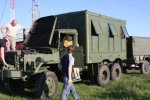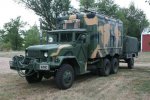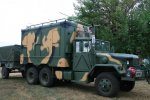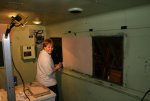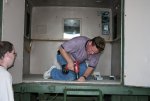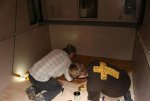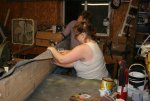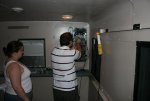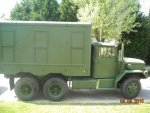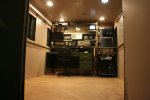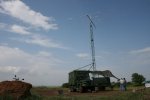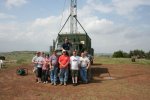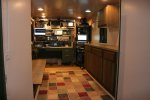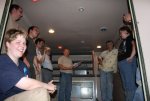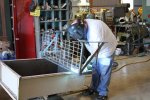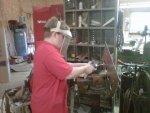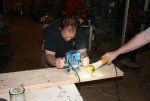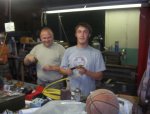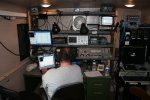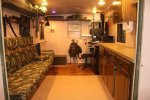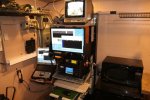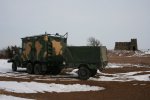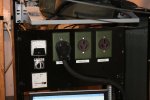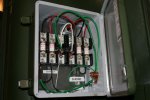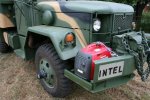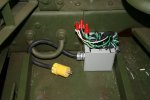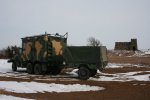Thought I would share about a M109A3 camper / radio shack build which I hope some will find it interesting in how it was accomplished.
But first I want to say thanks to this site and its members, for it is an outstanding go to source of information one needs to know in preserving a military vehicle.
In my spare time I serve as an adviser for the physics club and as a part time adjunct professor at a local college. I like to think I stay young in mind and spirit by being around college students who are mostly math, computer, and physics majors. My military service was in the late 60’s with a MOS of 88M, I’m older than the student’s parents.
First off these students were not into hand tools, including drills, saws, wrenches, soldering irons or skills like welding, painting, wiring, carpentry, changing oil, changing tires, fixing engines, etc. Not by choice, but rather they never had an opportunity to learn like most of us on this site did, from a parent, a mentor, or years of different job experiences. The M109A3 and community friends changed all this.
In the course of advising them on electronic projects for several years it became apparent they wanted to do more in the way of hands on electronic projects and since the school does not offer an electronic curriculum, I offered my lab / shop as a solution. Starting a year ago, for one night a week, anywhere from 3 to 12 students along with a number of local interested ham radio guys showed up for electronic tinkering and gadget building. It has been a great mix of college kids and men from the community who are 15 to 40 years their senior sharing knowledge and life experiences.
Once while showing and teaching how to find hidden transmitters, one student said maybe they could use this technology to locate / track players in their paint ball games. So we designed and built small tracking devices that would cover large fields and could be worn by paint ball players. Next they wanted a way to communicate with the “field contestants” (my generation would call them soldiers) so they could relay positional information from a command post. For that I said you need to get a ham radio license. Two months later 10 students had various levels of ham licenses and we were dodging paint balls and carrying radios while being vectored towards a target. Fun stuff.
For me this was an ah ha moment. If we can expose the students to different technologies and methods of making things happen, they can connect the dots and use it in their areas of interest. In this case radio technology and paint ball. It’s their way of “playing army”
In comes the M109A3.
I suggested we need a rolling ham shack that could serve as a test platform for radios and other experiments, including paint ball games. They agreed and I started looking for something that would work. Commercial vans were an option but not enough room. I joined the SS site while researching S-250 shelters but like the vans, not enough room for everyone. But there was an ad by a SS member for a real nice M109A3 that caught my eye; it was big enough for all of us. Though it is nice to dream big, it was a little more than what I thought I wanted to spend plus it was 1400 miles away. But I mentioned it to the students anyway just to see what their reaction would be thinking they would not want anything to do with a military truck. But to my surprise the students really took to the idea of having a surplus military truck to house electronics and radios, they said it would be cool, really different, and it could be used at public events to showcase their work or public service. Kind of a rolling club house, albeit a very unique club house.
So I spent some of my kid’s inheritance money and in May of 2010 the 1985 AM General M109A3 with a M105A2 trailer, a newer engine, low miles, and no rust was driven 1400 miles to Kansas to start a new life with kids that were not alive when this truck went into service.
The make over.
As the pictures show the students along with the local ham radio guys really got into converting it into a unique rolling camper, experiment platform, and club house, something we continue to use even in winter. It is a work in progress with changes and improvements being implemented almost on a weekly bases through out the summer of 2010. Students learned to arc weld, run a lathe, a mill, change oil, do wiring, install flooring, build shelving, with some tools they never knew existed, and of course install and operate a one of a kind mobile ham radio station. Everyone found something interesting to do.
We drove it to the MVPA convention in Topeka and was given a prominent parking spot in front of the expo center. This allowed the students to easily interact with the collectors and visitors thus learn history that would probably never be covered in the class room. The displays were truly amazing and the people were very gracious in telling their stories.
Local parades, ham radio field day, a set up inside a convention center, and a large article in the college’s alumni magazine were some of this year highlights with the M109A3. It gave us visibility in the community along with validation of their work.
In closing.
Our hobby offers a great opportunity to interact with people from all walks of life. In my case it was a chance comment to students that got this project started. I believe in "Pay it forward"
I like to think that a difference was made in these students’ lives. They have done things that very few have the opportunity to do in today’s world. I also like to think this project was a real world vocational training class that did not feel like school. We used playing to learn and they applied their college lessons to real world applications, a win win.
There were naysayers along the way. The most often heard comment was my liability if someone got hurt. But I personally think we have to take risks both as an individual and as a society if we want to make a difference. That is another subject all together but in this case this was a good decision on my part to teach by doing.
Some things we added to the M109A3;
Spin on oil filters
Block heater
Muffler
GPS for driver
Tilt up 40’ tower
Air conditioning
Electric heat
2 generators, one to use while in motion
Outside lighting
Roof rack
Outside cameras
Camo netting
Lock out hubs on front axel and first driver axel
Solid wood cabinets (hickory) with magnetic latches
Refrigerator, microwave, gas stove
High speed satellite internet
All band ham radio coverage
Room for expansion….
But first I want to say thanks to this site and its members, for it is an outstanding go to source of information one needs to know in preserving a military vehicle.
In my spare time I serve as an adviser for the physics club and as a part time adjunct professor at a local college. I like to think I stay young in mind and spirit by being around college students who are mostly math, computer, and physics majors. My military service was in the late 60’s with a MOS of 88M, I’m older than the student’s parents.
First off these students were not into hand tools, including drills, saws, wrenches, soldering irons or skills like welding, painting, wiring, carpentry, changing oil, changing tires, fixing engines, etc. Not by choice, but rather they never had an opportunity to learn like most of us on this site did, from a parent, a mentor, or years of different job experiences. The M109A3 and community friends changed all this.
In the course of advising them on electronic projects for several years it became apparent they wanted to do more in the way of hands on electronic projects and since the school does not offer an electronic curriculum, I offered my lab / shop as a solution. Starting a year ago, for one night a week, anywhere from 3 to 12 students along with a number of local interested ham radio guys showed up for electronic tinkering and gadget building. It has been a great mix of college kids and men from the community who are 15 to 40 years their senior sharing knowledge and life experiences.
Once while showing and teaching how to find hidden transmitters, one student said maybe they could use this technology to locate / track players in their paint ball games. So we designed and built small tracking devices that would cover large fields and could be worn by paint ball players. Next they wanted a way to communicate with the “field contestants” (my generation would call them soldiers) so they could relay positional information from a command post. For that I said you need to get a ham radio license. Two months later 10 students had various levels of ham licenses and we were dodging paint balls and carrying radios while being vectored towards a target. Fun stuff.
For me this was an ah ha moment. If we can expose the students to different technologies and methods of making things happen, they can connect the dots and use it in their areas of interest. In this case radio technology and paint ball. It’s their way of “playing army”
In comes the M109A3.
I suggested we need a rolling ham shack that could serve as a test platform for radios and other experiments, including paint ball games. They agreed and I started looking for something that would work. Commercial vans were an option but not enough room. I joined the SS site while researching S-250 shelters but like the vans, not enough room for everyone. But there was an ad by a SS member for a real nice M109A3 that caught my eye; it was big enough for all of us. Though it is nice to dream big, it was a little more than what I thought I wanted to spend plus it was 1400 miles away. But I mentioned it to the students anyway just to see what their reaction would be thinking they would not want anything to do with a military truck. But to my surprise the students really took to the idea of having a surplus military truck to house electronics and radios, they said it would be cool, really different, and it could be used at public events to showcase their work or public service. Kind of a rolling club house, albeit a very unique club house.
So I spent some of my kid’s inheritance money and in May of 2010 the 1985 AM General M109A3 with a M105A2 trailer, a newer engine, low miles, and no rust was driven 1400 miles to Kansas to start a new life with kids that were not alive when this truck went into service.
The make over.
As the pictures show the students along with the local ham radio guys really got into converting it into a unique rolling camper, experiment platform, and club house, something we continue to use even in winter. It is a work in progress with changes and improvements being implemented almost on a weekly bases through out the summer of 2010. Students learned to arc weld, run a lathe, a mill, change oil, do wiring, install flooring, build shelving, with some tools they never knew existed, and of course install and operate a one of a kind mobile ham radio station. Everyone found something interesting to do.
We drove it to the MVPA convention in Topeka and was given a prominent parking spot in front of the expo center. This allowed the students to easily interact with the collectors and visitors thus learn history that would probably never be covered in the class room. The displays were truly amazing and the people were very gracious in telling their stories.
Local parades, ham radio field day, a set up inside a convention center, and a large article in the college’s alumni magazine were some of this year highlights with the M109A3. It gave us visibility in the community along with validation of their work.
In closing.
Our hobby offers a great opportunity to interact with people from all walks of life. In my case it was a chance comment to students that got this project started. I believe in "Pay it forward"
I like to think that a difference was made in these students’ lives. They have done things that very few have the opportunity to do in today’s world. I also like to think this project was a real world vocational training class that did not feel like school. We used playing to learn and they applied their college lessons to real world applications, a win win.
There were naysayers along the way. The most often heard comment was my liability if someone got hurt. But I personally think we have to take risks both as an individual and as a society if we want to make a difference. That is another subject all together but in this case this was a good decision on my part to teach by doing.
Some things we added to the M109A3;
Spin on oil filters
Block heater
Muffler
GPS for driver
Tilt up 40’ tower
Air conditioning
Electric heat
2 generators, one to use while in motion
Outside lighting
Roof rack
Outside cameras
Camo netting
Lock out hubs on front axel and first driver axel
Solid wood cabinets (hickory) with magnetic latches
Refrigerator, microwave, gas stove
High speed satellite internet
All band ham radio coverage
Room for expansion….
Attachments
-
82.9 KB Views: 236
-
96.6 KB Views: 282
-
85.1 KB Views: 292
-
39.3 KB Views: 262
-
45.5 KB Views: 238
-
38.3 KB Views: 241
-
63.7 KB Views: 249
-
39.1 KB Views: 250
-
57.7 KB Views: 224



